Angela Ackerman's Blog: Writers Helping Writers, page 55
February 5, 2022
Relationship Thesaurus Entry: Mentor and Prot��g��
Successful stories are driven by authentic and interesting characters, so it’s important to craft them carefully. But characters don’t usually exist in a vacuum; throughout the course of your story, they’ll live, work, play, and fight with other cast members. Some of those relationships are positive and supportive, pushing the protagonist to positive growth and helping them achieve their goals. Other relationships do exactly the opposite���derailing your character’s confidence and self-worth���or they cause friction and conflict that leads to fallout and disruption. Many relationships hover somewhere in the middle. A balanced story will require a mix of these dynamics.
The purpose of this thesaurus is to encourage you to explore the kinds of relationships that might be good for your story and figure out what each might look like. Think about what a character needs (good and bad), and build a network of connections for him or her that will challenge them, showcase their innermost qualities, and bind readers to their relationship trials and triumphs.
Mentor and Prot��g��
Description: This relationship consists of an experienced mentor who has achieved a measure of expertise in a given area and a prot��g�� dedicated to learning from them and following in their footsteps. While a relationship can initially be established with this purpose in mind, the mentor/prot��g�� dynamic typically grows out of an existing relationship (teacher/student, coach/athlete, boss/employee). The interactions between the two parties will differ based on many factors and may change over time.
Relationship Dynamics:
Below are a wide range of dynamics that may accompany this relationship. Use the ideas that suit your story and work best for your characters to bring about and/or resolve the necessary conflict.
A mentor eagerly sharing the fruits of their knowledge with the prot��g��
A mentor taking a personal interest in their prot��g��
A mentor actively creating growth opportunities for the prot��g�����taking them to meetings and introducing them to other influencers, etc.
A mentor being open to learning from the prot��g��
A mentor jealously keeping the prot��g�� to himself
A mentor who doesn’t want the prot��g�� to move on (seeing him or her as a valuable resource rather than someone with potential) and doesn’t do what is needed to grow them
A mentor viewing the prot��g�� as an underling to do their busy work
A brilliant mentor who isn’t necessarily good at teaching or dealing with people
A mento taking the prot��g��’s lack of interest or ability personally
A prot��g�� recognizing what the mentor can provide and soaking up everything they can
A prot��g�� seeing the relationship not just as one that benefits him but also looking for ways he can help the mentor
A prot��g�� catching up with their mentor and growing past him or her
A prot��g�� taking the opportunity seriously, being responsible and showing gratitude
An overconfident prot��g�� not being open to feedback from the mentor
A prot��g�� seeking constant instruction, feedback, and affirmation from the mentor
A reluctant prot��g�� only putting in partial effort
An eager prot��g�� being distracted by personal problems and not giving the relationship their all
An unwilling prot��g�� being pushed into the relationship (by parents, a court order, etc.), resulting in apathy or resentment
Conflicting Desires that Can Impair the Relationship
The mentor wanting something different for the prot��g�� than the prot��g�� wants
Either party wanting more time, energy, or personal attention than the other is willing or able to give
The mentor wanting to teach a prot��g�� who is in the relationship for subversive reasons (to gain information for someone else, to set the mentor up for failure, to humiliate them, etc.)
A prot��g�� wanting to learn from a mentor who wants to control and subdue
The prot��g�� wanting to be taught and mentored while the mentor wants a lackey
Both parties wanting to be “top dog” in the relationship
Clashing Personality Trait Combinations: Controlling and Stubborn, Cooperative and Cocky, Trusting and Disloyal, Fussy and Disorganized, Decisive and Pensive, Ambitious and Lazy, Generous and Ungrateful, Independent and Needy
Negative Outcomes of Friction
The relationship ending prematurely
Poor communication leading to frustration and wasted time
A mentor feeling unappreciated or betrayed
The prot��g�� not learning anything meaningful from the relationship
The prot��g�� internalizing criticism and doubting they could achieve the same level of knowledge or success as the mentor
The mentor talking badly about the prot��g�� to colleagues, blackballing him or her
Either party being reluctant to enter into the same kind of relationship again
The prot��g�� becoming jaded, assuming other mentor figures are like this one
The mentor getting a reputation for being difficult or uncooperative
Fictional Scenarios That Could Turn These Characters into Allies
A challenging problem that needs solving
A personal problem for either party that the other can help with in some way
The parties learning that they share a passion
A outside threat to the mentor that could result in the relationship ending prematurely (a personal problem stealing time, their position at the job or university being threatened, etc.)
Ways This Relationship May Lead to Positive Change
The prot��g�� vastly expanding their knowledge
Either party overcoming a bias or stereotype regarding the other person
The mentor realizing that they have more to learn
Either party filling a personal void for the other���as a parental figure, for instance
Themes and Symbols That Can Be Explored through This Relationship
A Fall from Grace, A Quest for Knowledge, Inflexibility, Journeys, Knowledge, Mystery, Passage of Time, Perseverance, Stagnation
Other Relationship Thesaurus entries can be found here.
 Need More Descriptive Help?
Need More Descriptive Help?While this thesaurus is still being developed, the rest of our descriptive collection (15 unique thesauri and growing) is accessible through the One Stop for Writers THESAURUS database.
If you like, swing by and check out the video walkthrough, and then give our Free Trial a spin.
The post Relationship Thesaurus Entry: Mentor and Prot��g�� appeared first on WRITERS HELPING WRITERS��.
February 3, 2022
Writers, Be Your Own Valentine This Year

When February rolls around, it’s a reminder to let the people we know that we love and cherish them. So, we buy the traditional chocolate, flowers, and cards, or the gift of time in the form of a night out, or making a favorite meal or dessert.
In reality, most of us don’t need a special day to show love to others. But we do need a reminder to show love for the one we tend to forget about: OURSELVES.Many of you know we have a serious love of Maslow’s Hierarchy of Human Needs. We use it all the time to teach writers how to build stronger characters, meaningful arcs, and how to add meaningful conflict and stakes.
Well, if there were a hierarchy for a writer’s life, it would look something like this:
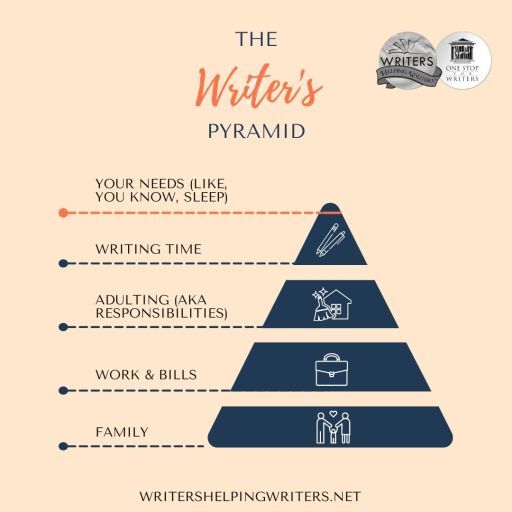
Feels, um, a little TOO accurate? And well, that’s not good.
So this year, I say you should think about how to be your own Valentine. Start with some meaningful gifts.
Give yourself the gift of space.We all live busy lives and end up trapped within responsibilities and routines. We’re used to taking every spare moment and filling it with stuff that must be done – errands, fixing things, appointments. When do we have time to reflect on what we need, what we want to see for ourselves, and what will bring us more happiness and fulfillment?

So…back away from the to-do list and give yourself some space to think and reflect. We only get one kick at the can of life (well, unless reincarnation is a thing), so go for a walk in the park, take yourself on a picnic, or fill the bathtub with suds and lock the door. Turn your thinker to what small changes you can make to move toward a happier and more balanced you.
Give yourself the gift of time.The Writer’s Pyramid shows how everything else tends to come first. After all, we love the people around us and want to make sure their needs are taken care of. But the constant merry-go-round of work, driving everywhere for school and appointments, and all the other life stuff doesn’t leave us a lot for writing and other fulfilling goals.
So…be a little selfish with your time this February. Putting your needs and interests first for once doesn’t make you a bad person. Pausing other things that can wait so you can make room for your writing and yourself is a healthy habit and teaches us to make choices about what’s really important. When you have more time for your and the things that are personal to you, you’ll be happier and more energized, too.
Give yourself the gift of escape.
Forgive me, Stephen King, for I have sinned. I have become so busy I barely have time to read anymore. In fact, I may have moved that stack of new books I bought just so I wouldn’t feel guilty about what I wasn’t doing…reading.
If this sounds familiar, it’s okay. You aren’t alone. A busy life means reading fiction can end up on the back burner. But we write because we love stories and want readers to escape into our realities. Reading is key to furthering our career and keeping our creative well filled.
So…let’s escape ourselves by going on a book date. Pick up that trilogy you’ve been eyeing. Buy yourself your favorite sweets, a new flavor of tea, or whatever will help you unplug from everything and focus on the fiction realm. Give yourself permission to put everything else on hold so you can fall into a fictional world.
Give yourself the gift of help.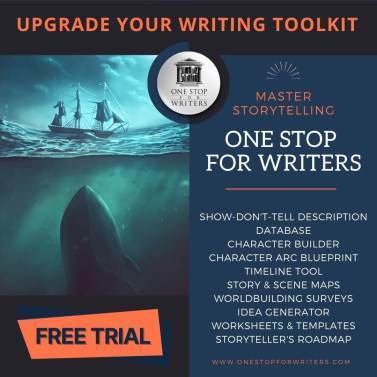
As many of you know, Becca and I are all about making writing easier for everyone. We’ve spent over a decade creating a stockpile of writing resources — books, software, and a ton of free stuff here, here, and here.
Most associate us with our thesaurus books, but we also have One Stop for Writers, which is a virtual treasure chest of storytelling goodness.
You’ll find everything you need to build standout characters, fresh plots and stunning worlds. And if you like to use our thesaurus books as you write, you’ll be happy to know a much larger description THESAURUS Database is at the site.

If you’d like to check it out, try the 2-week free trail. Or, if you need more time, use our one-use 50% off Valentine code for the 1-month plan:
BEMINE50You’ll get a full month of One Stop for under $5.
Just sign up, enter the code on the My Subscription page, and choose the 1-month plan. TIP: Be sure to check out the Storyteller’s Roadmap as it will help you get your story publish-ready.
Give yourself the gift of grace.Above all else, we want to see you get your books in the hands of readers and realize your writing dreams. Fulfillment is fuel, and when we achieve meaningful goals, we’re happier, more balanced, and optimistic. But writing a strong story and publishing it takes time, especially when we have a full life and other responsibilities.
So…take a moment to remind yourself that this isn’t a race, and you’re not competing with anyone. Publishing a book and having a successful career of doing what you love is about putting one foot in front of the other. Go at the speed that is right for you, not one that might lead to burnout. Be kind to yourself and remember: YOU’VE GOT THIS!
Give yourself the gift of sleep.Hit snooze and sleep in. The world will not break apart if you take a bit more rest for yourself, I promise. 
The post Writers, Be Your Own Valentine This Year appeared first on WRITERS HELPING WRITERS��.
February 1, 2022
6 Cheats to ���Tell��� Well (When It’s Warranted)
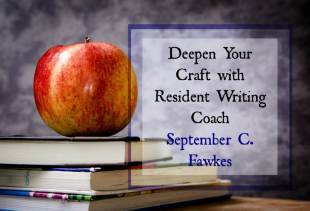
By September C. Fawkes
Most of us are familiar with the ���Show, don���t Tell��� rule. In short, it���s more effective to dramatize the story than to simply tell what happened. Nonetheless, almost every story needs at least some telling. It can help keep the pacing tight, relay background information, and enhance tone, among other things. Here���s more on when breaking the rule can work. So how do we tell well? Here are six cheats to help you.
1. Appeal to the SensesGood showing appeals to the senses. Basically, we have to appeal to the senses to really show a story. There is no reason moments of telling can’t appeal to the senses in a similar way. Appealing to sight, sound, smell, taste, or touch can strengthen your telling just as it does with showing. It’s just that with telling, it’s usually brief, or relayed “in passing.” This example appeals to senses despite it being a telling summary:
We drove through Georgia, Alabama, Tennessee, Kentucky, stopping to cool the engine in towns where people moved with arthritic slowness and spoke in thick strangled tongues . . . At night we slept in boggy rooms where headlight beams crawled up and down the walls and mosquitoes sang in our ears, incessant as the tires whining on the highway outside. – This Boy’s Life by Tobias Wolff
Some telling doesn’t lend itself to the senses very easily, because of the subject matter that needs to be told. In cases like that, you can try tying in a concrete comparison to suggest a sense. This example tells about a telepathic and emotional connection using comparisons:
At night awake in bed, he���d remember her presence. How their minds had been connected, ethereal like spider webs. How just her being there brought a sense of comfort, like a childhood blanket he hadn���t realized he���d still had.

Just as you use detail to make your showing great, you can and often should include detail in passages of telling. Mention a red leather jacket here or a specific cologne there. Of course, you won���t be including as much detail as you would with showing, but detail makes telling more realistic. One key to making this work is to pick the right details, as opposed to generic ones.
Their mom had always stressed the importance of eating dinner as a family, of stir fry nights and cloth napkins on laps, of hands held in prayer and laughter pealing off travertine, and even of the occasional green bean food fight.
You can also make telling stronger by making it more literary. Elevate the prose with smart word choices and by paying attention to rhythm and sound. Again, you can bring in similes and metaphors, or better yet, extended metaphors. Basically, you are finding a way to make what you are telling particularly pleasing and poetic.
From Crossed by Ally Condie:
In the night, it feels like we���re running fast over the back of some kind of enormous animal, sprinting over its spines and through patches of tall, thin, gold grass that now glimmers like silver fur in the moonlight.
The air is desert cold, a sharp, thin cold that tricks you into thinking you aren���t thirsty, because breathing is like drinking in ice.
Unfortunately, the poetic approach won���t work with everything���it likely won���t work in a comedic passage or an angry one. Instead, bump up the tone. Pull in the narrative voice or let the character’s voice bleed into the narrative at the deepest level. Channel the emotion of the narrator or character and write your telling in ways that reinforce that. For help, check out my previous post on WHW.
From The Book Thief by Markus Zusak:
Earlier, kids had been playing hopscotch there, on the street that looked like oil-stained pages. When I arrived, I could still hear the echoes. The feet tapping the road. The children-voices laughing, and the smiles like salt, but decaying fast.
Then, bombs.
This time everything was too late. The sirens. The cuckoo shrieks on the radio. All too late.
Misfortune?
Is that what glued them down like that?
Of course not.
Let’s not be stupid.
It probably had more to do with the hurled bombs, thrown down by humans hiding in the clouds.
6. Create Tension, Even if Only on a Small ScaleGood tension will keep a reader invested, even through telling. See if you can include tension when telling. It can be tension that lasts only for a sentence, or, better yet, promises of conflict yet to come.
From Harry Potter and the Sorcerer���s Stone:
The Dursleys had everything they ever wanted, but they also had a secret, and their greatest fear was that somebody would discover it.
They didn’t think they could bear it if anyone found out about the Potters.
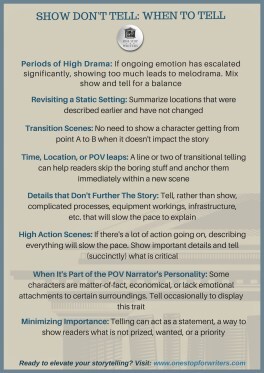
Click here for additional Checklists and Cheat Sheets���including one with great examples of telling and showing.
 September C. Fawkes
September C. FawkesResident Writing Coach
September C. Fawkes has worked as an assistant to a��New York Times��bestselling author and writing instructor, and now does freelance editing at FawkesEditing.com. She has published poetry, short fiction, and nonfiction articles, and her award-winning writing tips have appeared in classrooms, conferences, and on Grammar Girl. Grab this AMAZING guide on Crafting Powerful Protagonists at her website and find her on
Twitter �� Facebook �� Instagram �� Tumblr
The post 6 Cheats to ���Tell��� Well (When It’s Warranted) appeared first on WRITERS HELPING WRITERS��.
January 29, 2022
Relationship Thesaurus Entry: Giver and Taker
Successful stories are driven by authentic and interesting characters, so it’s important to craft them carefully. But characters don’t usually exist in a vacuum; throughout the course of your story, they’ll live, work, play, and fight with other cast members. Some of those relationships are positive and supportive, pushing the protagonist to positive growth and helping them achieve their goals. Other relationships do exactly the opposite���derailing your character’s confidence and self-worth���or they cause friction and conflict that leads to fallout and disruption. Many relationships hover somewhere in the middle. A balanced story will require a mix of these dynamics.
The purpose of this thesaurus is to encourage you to explore the kinds of relationships that might be good for your story and figure out what each might look like. Think about what a character needs (good and bad), and build a network of connections for him or her that will challenge them, showcase their innermost qualities, and bind readers to their relationship trials and triumphs.
 Giver and Taker
Giver and TakerDescription: In this codependent relationship, each party gets something that they need, but in an unhealthy manner. The giver goes to great lengths to please and help the taker, often sacrificing their own needs, desires, health, and mental well-being to serve the other person. This can result in the giver being abused, neglected, taken advantage of, or otherwise mistreated by the taker. In the end, they both benefit, albeit dysfunctionally: the taker gets someone to care for them while the giver gets what they need (gaining the taker’s approval, finding purpose in serving them, etc.).
This dynamic can be found in any pairing���between spouses, friends, a parent and child, coach and athlete, boss and employee, etc.
Relationship Dynamics:
Below are a wide range of dynamics that may accompany this relationship. Use the ideas that suit your story and work best for your characters to bring about and/or resolve the necessary conflict.
The giver struggling to say no to the taker, no matter how selfish the request
The giver making excuses for the other party, even taking the on the blame for the taker’s actions
The giver finding their identity as a caregiver or in relationship to the other person (instead of having their own individual identity)
The giver sacrificing their own needs in favor of the taker’s
The giver being unaware of their own needs or being unable/unwilling to communicate them
The giver experiencing frequent stress or anxiety due to never knowing where they stand with the taker
The giver playing the peacemaker���doing whatever it takes to mend the relationship after an argument
The giver taking personal responsibility for the taker’s happiness
The giver believing that no one can care for the taker like they can
The taker guilting, bullying, or manipulating the giver into doing something for them
The taker mistreating the giver, then attempting to make up for it with through gifts or gestures
The taker expressing dissatisfaction with how a giver is doing things
The taker controlling every aspect of the giver’s life
The taker becoming jealous if the giver gives their time or attention to anyone else (including their child, parent, sibling, etc.)
The taker showing little or no interest in the giver’s true needs or desires
The taker refusing to negotiate or compromise with the giver (my way or the highway thinking)
Conflicting Desires that Can Impair the Relationship
The giver wanting to be treated as an equal while the taker wants to be in charge
One party wanting out of the relationship
The taker demanding something the giver is uncomfortable doing
The giver wanting to care for someone else (a child, for instance) while the taker wants all of the giver’s attention
The giver wanting to believe or embrace something the taker doesn’t agree with
The giver needing a mental break from caregiving, but the taker refusing to comply
The giver wanting a level of autonomy that the taker is unwilling to allow
Clashing Personality Trait Combinations:
Controlling and Rebellious, Perfectionist and Flaky, Extravagant and Thrifty, Cruel and Oversensitive, Manipulative and Weak-Willed, Pushy and Independent, Needy and Apathetic
Negative Outcomes of Friction
Physical abuse
Emotional abuse
The taker’s self-esteem plummeting
Fear of losing the relationship keeping the two together in an unhealthy relationship
Children seeing the dysfunction and continuing it in their own relationships
The giver feeling isolated, having no one to confide in
Either party turning to substance abuse as a coping mechanism (or increased use, if it’s already part of the equation)
Fictional Scenarios That Could Turn These Characters into Allies
A “rock bottom” scenario in the relationship that requires changes be made if they are to stay together
Working together to help a mutual friend, the taker’s boss, or someone who needs help
A medical emergency that requires the taker to adopt the caregiving role and the giver to accept the taker’s help to return to health
A spiritual awakening that causes a change in one or both parties, causing them to want to heal the relationship
Ways This Relationship May Lead to Positive Change
Either party seeing an example of a healthy relationship and wanting it personally
Regaining a healthy relationship through self-revelation and therapy
Either party leaving so they can focus on their own health and well-being
Children seeing the dysfunction and vowing to do things differently in their own relationships
Themes and Symbols That Can Be Explored through This Relationship
Beginnings, Deception, Depression, Enslavement, Family, Freedom, Friendship, Health, Hope, Instability, Isolation, Journeys, Love, Obstacles, Perseverance, Sacrifice, Suffering, Transformation
Other Relationship Thesaurus entries can be found here.
 Need More Descriptive Help?
Need More Descriptive Help?While this thesaurus is still being developed, the rest of our descriptive collection (15 unique thesauri and growing) is accessible through the One Stop for Writers THESAURUS database.
If you like, swing by and check out the video walkthrough, and then give our Free Trial a spin.
The post Relationship Thesaurus Entry: Giver and Taker appeared first on WRITERS HELPING WRITERS��.
January 27, 2022
Phenomenal First Pages Contest
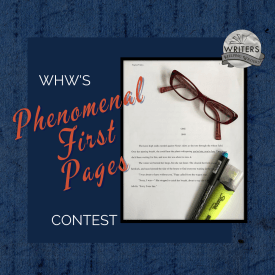 Hey, wonderful writerly people! It���s time for our monthly first-page critique contest
Hey, wonderful writerly people! It���s time for our monthly first-page critique contest 
If you���re working on a first page (in any genre except erotica) and would like some objective feedback, please leave a comment. Any comment :). As long as the email address associated with your WordPress account/comment profile is up-to-date, I���ll be able to contact you if your first page is chosen. Just please know that if I���m unable to get in touch with you through that address, you���ll have to forfeit your win.
Two caveats:
 Please be sure your first page is ready to go so I can critique it before next month���s contest rolls around. If it needs some work and you won���t be able to get it to me right away, let me ask that you plan on entering the next contest, once any necessary tweaking has been taken care of. Resources for common problems writers encounter in their opening pages can be found here.
Please be sure your first page is ready to go so I can critique it before next month���s contest rolls around. If it needs some work and you won���t be able to get it to me right away, let me ask that you plan on entering the next contest, once any necessary tweaking has been taken care of. Resources for common problems writers encounter in their opening pages can be found here.
 This contest only runs for 24 hours, start to finish, so get your comment in there!
This contest only runs for 24 hours, start to finish, so get your comment in there!
Three commenters��� names will be randomly drawn and posted tomorrow morning. If you win, you can email me your first page and I���ll offer my feedback.
We run this contest on a monthly basis, so if you���d like to be notified when the next opportunity comes around, consider subscribing to our blog (in the sidebar).
Best of luck!
PS: If you want to amp up your first page, grab our helpful First Pages checklist from One Stop for Writers. And for more instruction on these important opening elements, see this Mother Lode of First Page Resources.The post Phenomenal First Pages Contest appeared first on WRITERS HELPING WRITERS��.
January 25, 2022
Writing Magic in a Real-World Setting
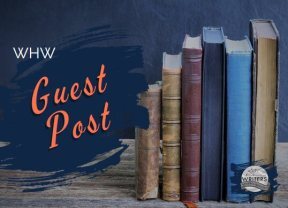
By Liz Keller Whitehurst
For centuries, people have been spellbound by magic and the supernatural. Ghosts, curses, talking creatures, portals to alternate dimensions���there’s just too much creative fodder for authors not to plumb those depths. Over time, mainstream fantasy has given way to many other genres���particularly those where magic is being used in a real-world setting.
Melding the fantastic with the everyday definitely has its challenges, but it can be done. Whether you’re writing magical realism, fabulism, or an undefined genre in a similar vein, you’ve got to thread the needle when it comes to blending magic with the real world. Here are some tips on how to do that.
The First Rule of Magic is ContainmentCreativity guru Julia Cameron uses this concept in her Artist Way work, but she certainly didn���t coin the phrase. What does the first rule of magic is containment mean?
Keep the mystery.

The best magic is always shrouded in mystery. Here���s where ���show, don���t tell��� is your best friend. Don���t explain too much of your magic or how it works to your readers. Readers love to figure out what���s going on in a story, to feel the frisson of wondering, is there a logical explanation for this or is something more going on? Leave them wondering. Do the same with your characters, especially the ones who observe the magic rather than create it. What do they think about it? How do they try and explain what���s happening?
A Little Magic Goes a Long WayIntegral to the idea above, don���t overwhelm your reader with too many magical or fantastical events. If you do, you���ll ruin the mystery. Season your writing with it. Don���t make every character a part of the magic or even include it in every scene. Less is more.
Magic Has to Make SenseWhenever you decide to include magical elements or events, be certain of two things. First, you, as the writer, are very clear about what is happening and how it���s happening. You clearly understand the parameters, the ins and outs of the magic. As we discussed earlier, you do not reveal all of this to your reader. But it’s crucial that you “get it.” Also, the magic must be organic to both your story and/or character, not come out of left field. If it looks like you just threw it in, you���ll break what one of my writing teachers called the narrative dream. You���ve crossed the line. The reader���s suspension of disbelief will evaporate.
Make Your World RealTo successfully incorporate magic into your real-world setting, your first job is to clearly establish the world in which the magic occurs. Creating a detailed, concrete setting is key. And that starts with the five senses.

Sensory details ground your readers so they have their bearings. Fill your writing with specific details about how this world looks, sounds, smells���be it New York City or a small town where everyone knows everyone else. Make your fictional world accessible and relatable. As much as possible, make the setting so vivid that it becomes like a main character. Setting as character will anchor the magic and create credibility for whatever might then happen.
Make Your Characters RealYour main characters should feel real, also. Strive to create strong, multi-dimensional characters readers feel like they know, so any magic they create is just one dimension of their complex character. They should have flaws, insecurities, and events from their past that have molded them into who they are in the current-day story. Understand what their emotional range is so you can write realistic and consistent responses to the things that will happen to them.
TIP: For deep-level character exploration, there’s no better tool than the Character Builder at One Stop for Writers.
Dialogue also goes a long way in fleshing out a character beyond any magic they might bring.
Make your Plot RealEvery successful story contains a dynamic plot and a strong narrative arc. Any magic must seem organic to both plot and arc and serve to progress and enhance them. Magical twists must feel inevitable instead of veering into plot detours that suck energy out of the narrative arc you���ve fueled. Ask yourself: Could this plot twist be told without the magic? If your answer is No!, you���re on the right track.
Magic in the Real World is Hard WorkUsing the above tools to add magic to your story world will spice up your writing. Trusted first readers can be crucial to guide you to step back and analyze how successful your efforts are. It’s also important to study the writers who have done well in your magical genre. How did they do it? How did they maintain your suspension of disbelief without waking you from the narrative dream? How did they incorporate magic in a way that you cannot imagine the story without it?
There���s no doubt about it. With focused study of the fantastic and a little extra effort, you can create���well, magic.

Liz Keller Whitehurst is the author of the recently released novel, Messenger, and author/creator of the serial podcast MESSENGER: A NOVEL IN 16 EPISODES, which she launched in 2020. Her short stories have appeared in many literary magazines and journals. She was also a finalist in Nimrod International Journal���s Short Story Competition.
In addition to fiction writing, Liz has spent her professional life writing and teaching. She���s done corporate, non-profit and freelance writing and has taught English and writing at the university level. Her last teaching post was co-leading a memoir writing class at the city jail.
Though born in Ohio, Liz grew up in Winchester, Virginia and has lived her adult life in Richmond, Virginia. She shares her current 1891 home, located in one of Richmond���s oldest neighborhoods, with her husband. You can find Liz on her website, Instagram, and Facebook.
The post Writing Magic in a Real-World Setting appeared first on WRITERS HELPING WRITERS��.
January 22, 2022
Relationship Thesaurus Entry: Fling
Successful stories are driven by authentic and interesting characters, so it’s important to craft them carefully. But characters don’t usually exist in a vacuum; throughout the course of your story, they’ll live, work, play, and fight with other cast members. Some of those relationships are positive and supportive, pushing the protagonist to positive growth and helping them achieve their goals. Other relationships do exactly the opposite���derailing your character’s confidence and self-worth���or they cause friction and conflict that leads to fallout and disruption. Many relationships hover somewhere in the middle. A balanced story will require a mix of these dynamics.

The purpose of this thesaurus is to encourage you to explore the kinds of relationships that might be good for your story and figure out what each might look like. Think about what a character needs (good and bad), and build a network of connections for him or her that will challenge them, showcase their innermost qualities, and bind readers to their relationship trials and triumphs.
Description: A fling is a casual, sexual relationship between two people. Unlike one-night stands, a fling is more than one encounter, but wouldn’t be considered an affair because it lacks emotional attachment. Flings generally happen between two people who want something fun and ‘in the moment’ rather than to invest in each other with the intent of building something more.
Relationship Dynamics:
Below are a wide range of dynamics that may accompany this relationship. Use the ideas that suit your story and work best for your characters to bring about and/or resolve the necessary conflict.
A relationship based upon physical attraction and sexual desires
Choosing a partner who is fun in bed but not “marriage material”
Enjoying casual sexual encounters with no expectation of other involvement
Getting together only when the timing works out (often at the last minute)
Keeping conversation superficial to avoid getting too personal
Not discussing the future, just enjoying the present
Minimal contact between encounters
Making no commitments or demands
Not probing for information even when a partner seems interesting
Avoiding situations that could lead to vulnerability or openness
Experimenting sexually if it’s fun and consensual
Leaving once a sexual encounter is over
Enjoying teasing and innuendo
Becoming worried if there’s too much common ground
One person realizing they might be developing feelings
Knowing deep down it’s time to break things off, but finding excuses not to
Asking questions that are more personal (suggesting investment)
Reading into certain actions and seeing intimacy (which may or may not be the case)
Having deeper feelings about the other person (but keeping them a secret)
Feeling jealous of the partner’s other relationships and hiding it
Pretending it’s a casual encounter yet doing things considered intimate (cooking a romantic dinner, sharing feelings, getting personal, etc.)
A relationship where one person is emotionally invested while the other is not
Conflicting Desires that Can Impair the Relationship
One person wanting to end things while the other does not
One partner pushing to try a committed relationship ‘to see what happens’
Wanting to expand the fling to include others but the partner does not
Both wanting something more, but one partner’s fears are preventing it
One participant pressuring the other to try things they aren’t comfortable with
One wanting to transition to a friendship, but the other liking things as is
Wanting to stay in touch after a fling ends but the partner does not
Threats to expose the fling if the other tries to end it
A partner who likes taking casual pictures or video together, but the other doesn’t want any evidence of the fling
Clashing Personality Trait Combinations: Gossipy and Private, Apathetic and Passionate, Controlling and Timid, Mischievous and Humorless, Irrational and Sensible, Affectionate and Inhibited, Needy and Independent, Honest and Evasive
Negative Outcomes of Friction
Being unable to go back to a previous relationship before it became a fling
Arguments about whether to continue or end things
One party disclosing the fling to others without consulting their partner first
The fling being discovered, damaging reputations and causing fallout (at work, with family, etc.)
Being blackmailed or threatened by the other person or a third-party
Awkwardness in social or professional situations when partners run into each other
Losing a mutual friend who chooses a side when the fling ends badly
Becoming fixated on swaying the other person to want the same thing
Reduced self-esteem or feelings of regret (if the fling was a mistake)
An increased fear of commitment
Becoming used to having a mental wall of distance which makes it harder to be vulnerable in other relationships
Fictional Scenarios That Could Turn These Characters into Allies
Mutually wanting to turn the fling into a committed relationship
A pregnancy
Both knowing this relationship could ruin lives if discovered
Working together to keep the fling a secret
Bonding over pressure from outsiders to be in a committed relationship
A mutual friend needing their support
One party experiencing personal difficulties and the other stepping up to help
A shared traumatic experience, or discovering common ground regarding a past one
Both parties coming out of bad relationships simultaneously
Both people agreeing that they are better off as friends
Ways This Relationship May Lead to Positive Change
Discovering layers of someone that go beyond what one previously knew
Getting to experience what clear boundaries are if this isn’t typical
Self-reflecting on one���s relationship choices to better understand what one wants
Learning the pros and cons of an uncommitted relationship
Exploring what one wants from a romantic partner and feeling safe to experiment
Feeling empowered to end an unhealthy relationship
Being able to safely process after-affects of a bad relationship, so baggage isn’t carried forward to the next committed relationship
Feeling empowered to make decisions that are right for them, not others
Discovering that a fling isn’t a good fit and so being able to focus fully on what is wanted and needed
Themes and Symbols That Can Be Explored through This Relationship
A fall from grace, Betrayal, Coming of age, Crossroads, Deception, Depression, Freedom, Friendship, Hope, Innocence, Instability, Journeys, Loss, Love, Mystery, Pride, Purity, Rebellion, Recognition, Refuge, Religion, Stagnation, Transformation, Vanity, Vulnerability
Other Relationship Thesaurus entries can be found here.
 Need More Descriptive Help?
Need More Descriptive Help?While this thesaurus is still being developed, the rest of our descriptive collection (15 unique thesauri and growing) is accessible through the One Stop for Writers THESAURUS database.
If you like, swing by and check out the video walkthrough, and then give our Free Trial a spin.
The post Relationship Thesaurus Entry: Fling appeared first on WRITERS HELPING WRITERS��.
January 20, 2022
���Perfect to Me���: How Self-Editing Can Take Your Novel to the Next Stage

By Michelle Barker
Part of the trick of hiring an editor is knowing when your manuscript is ready to hand over to them. There���s no point submitting a draft that you already know has POV issues or structural problems. The ideal situation I like to be in when I deliver my manuscript to an editor is that I think it���s perfect. Of course, it never is, but ���perfect to me��� means I���ve done everything I know how to do. That way, the editor will teach me something.
There are three main types of edits: developmental, line, and proofreading. At each stage, an author can do a lot of self-editing to create a ���perfect-to-me��� manuscript.
The Developmental StageA developmental edit tackles big-picture issues: plot, structure, characterization, point of view and the like. It can be hard to see where a novel isn���t working on a substantive level. Sometimes you know it���s not working but can���t figure out why. In both cases, I find it helpful to work through structural exercises.
List the major structural elements that should appear in a novel and fill in the blanks. You can go as basic as three-act structure (inciting incident, midpoint, climax, etc.) or you can get more detailed with something like a Save the Cat beat sheet. It amounts to the same thing: a novel must build momentum and it does this by hitting certain pivotal moments. If while doing this exercise you discover you���ve skipped a step or two, that���s probably where your problem lies.
Literary agent Hannah Sheppard boils this process down to a single sentence: When A (inciting incident) happens, B (character) must do C (action) otherwise/before D (catastrophe). Try filling it in. If you can���t, you���ll know there���s a problem.
One of the most common developmental issues I encounter as an editor is the protagonist���s lack of a strong, measurable goal. This goal needs to power the main character through the whole manuscript. One way to test this is to write a synopsis of the novel. Yuk, I know. A synopsis shows flaws. It���s a scary process. If you can���t boil your story down to a few pages that clearly trace a protagonist���s quest for a goal, you���ve got trouble.
Another thing a synopsis will reveal is causality (or the lack of it). If you find yourself connecting plot elements with the words, ���and then,��� (as opposed to ���but,��� or ���therefore���), your story won���t be building the momentum it needs to hold a reader���s attention.
Has your protagonist done something at the end of the novel that he couldn���t have done at the beginning? If not, you have a character arc issue.
I could write an entire piece on point of view���and indeed, many editors have. Go read a few of them. I will say one thing here. It seems like it would be easiest to write in omniscient so you have access to every character���s thoughts. In fact, it���s the hardest POV to master.
Don���t be tempted to add new business to a novel to solve an existing problem. Often, you simply haven���t delivered on the promises you���ve made.

Most clients I deal with believe one developmental edit is all their novel needs. In fact, it takes several passes to wrinkle out developmental issues. Writing a novel is (or should be) like building a house of cards. Remove one card and half the house topples. Developmental edits are hard for that reason. As soon as you solve one problem, you���ve created five others. You should not expect this to be a quick and simple job. Most writers are in too much of a rush. Good work takes time. A novel benefits greatly from smoking on the shelf for a month or so after a major edit. Indeed, time might be the best editor of all.
Sometimes clients are tempted to skip the developmental stage. Because they���ve worked for so long on their novels and have used beta readers, they believe they can jump straight into a line edit and (bonus) save some money. Skipping the developmental stage is like building a house on sand. Even when I���ve worked for a year on a novel and finally decide it���s ready to send to my publisher, the first thing they do is assign me���you guessed it���a developmental editor.
Line EditOnce the developmental issues have been tackled���and only then���it���s time to move onto a line edit. The most useful self-editing tool I can suggest before you send your work to an editor is to read the entire novel out loud in as short a time span as you can manage. The errors your eyes glossed over will sound like nails on a chalkboard to your ears. Missing words, repetitions, logical flaws, sheer boredom���I���ve encountered all of these in my own manuscripts, even after reading the work countless times in my head. I never noticed the flaws until I heard them.
A line edit is the most expensive editing job of the three. The worse shape your novel is in, the more you���ll pay. A line editor won���t fix developmental flaws. We���ll make suggestions, sure. We will move sentences and change words, but if the book is fundamentally flawed, that���s like repainting a room when the walls need to come down.
When I���m reviewing my own novel at this stage, I���m looking for certain things:
Is every scene grounded in physical and/or sensory detail?Have I noticed pet words or phrases repeating themselves ad nauseum? The common offenders include: of course, just, very, little���as well as all those useless generic gestures that do nothing to develop character: laughing, smiling, looking, shrugging, nodding.Does every scene contain tension? Does every chapter end with it?Have I let the novel sit? Yes, I���ve mentioned this twice now. That���s how important it is.ProofreadingProofreading comes at the end of the process. All the other issues should have been fixed by now. If you���re still finding problems with grammar and verb tenses���or worse, structural issues���your novel isn���t ready to send to the proofreader.
Run your manuscript through a spell- and grammar- check. If your novel contains complicated spellings of proper names, use the find/replace functions to make sure you���ve been consistent. Even if you���ve proofread until your eyes are crossed, I guarantee a proofreader will catch things you���ve missed. Don���t skip this stage, especially if you���re self-publishing.
It���s tempting to assume that because a manuscript seems perfect to you, it���s good enough and doesn���t need an editor. Never in my life have I handed over a manuscript to an editor and been told there���s nothing wrong with it, nor have I ever delivered that news to a client. Writing is a learning process, and because every story is different, they each have something to teach us about the craft.
PSSST! If you’re struggling with the revision stage of your story, One Stop for Writers has a Revision Roadmap to take you step-by-step through the process of fixing, tightening, and tidying up your manuscript .

Michelle Barker is the award-winning author of The House of One Thousand Eyes. She is also a senior editor at darlingaxe.com, a novel development and editing service presently offering a special NaNoWriMo deal for authors (https://darlingaxe.com/blogs/news/post-nanowrimo).
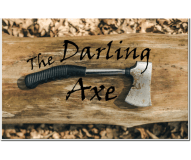
Her newest novel, My Long List of Impossible Things, was released in 2020 with Annick Press. You can find her on Twitter (@MBarker_190) Facebook (@MichelleBarkerAuthor), and her website www.michellebarker.ca.
The post ���Perfect to Me���: How Self-Editing Can Take Your Novel to the Next Stage appeared first on WRITERS HELPING WRITERS��.
January 18, 2022
Using Physical Pain to Show a Character’s Past Trauma
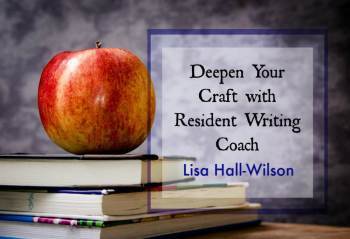
By Lisa Hall Wilson
There doesn���t seem to be much info out there to tell writers how to realistically capture emotions and trauma while still leaving room for plot, characterization, and genre tropes.
The most common problem I see is that the character THINKS about their past trauma���they have flashbacks and backstory���but the writer seems to forget that the character is a whole person. Trauma (past or present) should be felt in the character���s whole body, and pain is one of the devices that is often overlooked to show that trauma, to show increasing tension, to show internal conflict and build character arc.
Writing the Lived ExperienceReaders are not looking to read a lab report. The objective listing of details and descriptions (or symptoms) add little meaning for readers without context���particularly, emotional context.
The lived experience of trauma must include how a character���s emotions affect the body alongside the impacts to more tangible effects, like relationships and school and work.
If your goal is to create an emotional connection with readers, show them how this trauma FEELS in every fiber of the character���s being (where it���s relevant to the story). Show how that trauma makes every decision more difficult because going against whatever revives the emotional pain or creates a sense of being ���unsafe��� is essentially creating an internal war the character feels they can���t win.
Google can give you lists and clinical symptoms, but I���ve found forums a great source of lived-experience info because people often share their personal accounts as they look for support or advice.
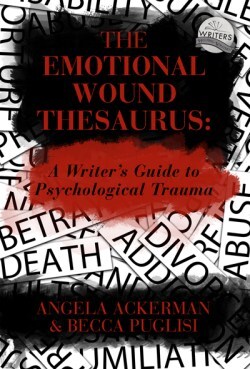
Note from Angela: To help writers brainstorm emotional wounds and understand how they shape a character’s behavior, fears, missing needs, false beliefs, etc. and impact character arc, we created The Emotional Wound Thesaurus: A Writer’s Guide to Psychological Trauma.
But keep going with your curiosity. How does the trauma affect the character���s thinking, priorities, choices and decisions, confidence, energy levels, goals ��� everything? This is a fantastic way to show escalation of internal tension for your character!
When Does Trauma Cause Physical Pain?
The obvious answer is physical injury, right? If you���re hit by a car, you���re likely to experience trauma ��� and a broken leg. However, writers often overlook physical pain as a sign that trauma memories and emotions are being suppressed or denied, how long-term trauma responses take a physical toll on the body, and how thoughts or patterns of thinking can create pain in the body. Coping strategies lose efficacy over time and psychosomatic pain turns into chronic or even life-long medical issues.
Pain from emotional trauma is the body���s desperate attempt to warn us that something isn���t right and needs our immediate attention. Use this natural function to SHOW your reader that everything is not okay.
Ripley pressed the heel of her hand into her sternum, her shoulders caving around the pain. But what if Steve is at the party? What if she has to talk to him? The pain deepened and her pulse kicked at her throat. She leaned back into the chair, stretching to relieve the pain but there was no escaping it. She can���t see him. Like that afternoon had never happened. Like he���d never held her down. Her chest tightened more. Her ribs ached with every breath, wouldn���t expand for a deep breath. Her heart pounded up into her throat. Was she dying?
Use Pain to Show Trauma BackstoryPain is a great device to show a backstory of trauma. Many writers are familiar with using minor aches or pain to show stress or tension, and that���s fine. The language of a stiff spine, clenched fists, or aching shoulders and necks is very relatable. But there���s so much more to it than that.
Try using pain that gets ignored, suppressed, or self-medicated without seeking treatment. Consider illness or pain that has no medical explanation (psychosomatic or psychogenic), or a series of worsening symptoms and diagnoses. Show a character desperately seeking to validate that their pain isn���t all in their heads. It���s important to show the character���s thinking behind the pain (their internal reaction to it) for the reader to understand what���s going on. It���s a great use of subtext.
Sally stuffed three chocolate-covered peanuts in her mouth and on the first bite a sharp pain shot up into her sinus. Her tongue carefully moved the nuts farther back in her mouth to avoid the sensitive tooth. She still had a couple of solid molars to chew with.
Use Pain and the Body as an Alarm System for ReadersSome trauma pain is psychosomatic (physical symptoms without a medical cause). For instance, anxiety can cause heart attack-like symptoms: racing pulse, intense chest pains, and shortness of breath. These are actual physical symptoms that drive people to emergency rooms all the time. You can clarify that the attack isn’t really heart-related by showing your reader the other key symptoms that don’t fit the diagnosis, such as the randomness of the attacks, the character’s pain remaining static in intensity for a long period of time, an attack being brought on by specific thoughts or upcoming events, etc.
But there are also medical conditions, physical illnesses, and disabilities that can result from emotional trauma. Fibromyalgia and psychogenic seizures can be caused by psychological distress. There are measurable markers of emotional pain from trauma, such as elevated cortisol levels. According to the Mayo Clinic:
���Cortisol, the primary stress hormone, increases sugars (glucose) in the bloodstream, enhances your brain’s use of glucose and increases the availability of substances that repair tissues.
Cortisol also curbs functions that would be nonessential or harmful in a fight-or-flight situation. It alters immune system responses and suppresses the digestive system, the reproductive system and growth processes. This complex natural alarm system also communicates with the brain regions that control mood, motivation and fear.���
Your character and the reader likely won���t be aware of an elevated cortisol level; maybe that���s just for you to know. But it���s now plausible for your character to develop diabetes even though they don���t eat a lot of sugar, to be more susceptible to illness, struggle to lose weight, have irregular and/or very painful menstrual cycles, experience sugar cravings after panic or intense stress, have sudden outbursts of anger or rage, or constantly be dealing with dental problems. Some of these aren���t pain signals specifically, but they cause a waterfall effect of growing physical problems.
Pain Builds upon PainLet���s look closer at the chain reaction of trauma pain. Consider sleep disruptions from emotional trauma (something that is super common). Exhaustion has all kinds of implications for the body and the mind: headaches or migraines, body aches, joint pain, clumsiness, stinging eyes, rapid breathing, elevated resting heart rate, sudden heart rate spikes, impaired thinking and reasoning, lack of focus, low energy, memory issues, depression��� You get the idea.
Now, compound that even further. Your character starts having performance issues at work. One day, they forget to pick up the baby from daycare. They get in an accident because they can���t focus while driving. They slip on the stairs and suffer a concussion.
For a character who is tired or in pain, EVERYTHING is more difficult.
Be Honest About the Consequences of Living with Pain
I love the spoon theory (the economy of energy) to explain how debilitating pain can be. Let’s say a person without chronic pain begins each day with ten spoons (total available energy for the day). They go for a run, which uses up two spoons, spend half a spoon on a shower, and use five spoons over the course of their work day. They return home in the evening with two and a half spoons left for a hobby, to make dinner, or go out to the bar.
The person who is managing chronic physical/emotional pain or is struggling with depression, PTSD, or anxiety may begin most days with only five spoons, and that shower might cost them two. They learn to hoard their spoons because they’re a finite resource that has to last all day. Just like in real life, that chronic pain will change everything for your character���their thinking patterns, priorities, decision-making abilities, susceptibility to depression. Everything.
The body’s response to trauma is very unique and individual, but when we use it strategically, it’s a great way to show not just past trauma, but internal tension, characterization, and conflict, as well.
How could you incorporate any of these tips into your WIP?Lisa is running her 5-week deep dive masterclass on writing in deep point of view in January, 2022. Check out her free Facebook group for more details and signup links.
 Lisa Hall-Wilson
Lisa Hall-WilsonResident Writing Coach
If Lisa had a super-power it would be breaking down complicated concepts into digestible practical steps. Lisa loves helping writers ���go deeper��� and create emotional connections with readers using deep point of view! Hang out with Lisa on Facebook at Confident Writers where she talks deep point of view.
Twitter �� Facebook �� Website �� Pinterest
The post Using Physical Pain to Show a Character’s Past Trauma appeared first on WRITERS HELPING WRITERS��.
January 15, 2022
Relationship Thesaurus: Frenemies
Successful stories are driven by authentic and interesting characters, so it���s important to craft them carefully. But characters don���t usually exist in a vacuum; throughout the course of your story, they���ll live, work, play, and fight with other cast members. Some of those relationships are positive and supportive, pushing the protagonist to positive growth and helping them achieve their goals. Other relationships do exactly the opposite���derailing your character���s confidence and self-worth���or they cause friction and conflict that leads to fallout and disruption. Many relationships hover somewhere in the middle. A balanced story will require a mix of these dynamics.
The purpose of this thesaurus is to encourage you to explore the kinds of relationships that might be good for your story and figure out what each might look like. Think about what a character needs (good and bad), and build a network of connections for him or her that will challenge them, showcase their innermost qualities, and bind readers to their relationship trials and triumphs.
Frenemies
Description: Frenemies are friends or acquaintances who are also, on some level, rivals or adversaries. Maybe they have to get along on a sports team or at work but they’re vying for the same position. Perhaps insecurities accentuate the negative aspects of the relationship and stifle the positives. Personal politics may require them to maintain a veneer of friendliness, but at its core, the relationship is more about winning or exerting power. The frenemy relationship is a complex one that, if it fits your story, can add a ton of conflict and depth.
Relationship Dynamics
Below are a wide range of dynamics that may accompany this relationship. Use the ideas that suit your story and work best for your characters to bring about and/or resolve the necessary conflict.
Characters getting along fine until a competitive element is introduced, at which point they go for blood
Athletic teammates cooperating to get a win but dedicating themselves personally to outdoing each other
One friend being reluctant to share information or cooperate with their frenemy co-worker or teammate because they don’t trust the other person’s motives
Both parties putting on a friendly front when they’re around other people but secretly not wanting anything to do with the other
One party alternating from friendliness and respect to manipulation and snubbing, constantly putting the other person off-balance
A superficial and disingenuous relationship that’s based on keeping one’s friends close but their enemies closer
Two parties not really liking each other but maintaining a civil relationship due to a long history together
Two people being fine one-on-one but turning into rivals when other friends or romantic interests enter the scene
One character constantly being sucked back into relationship with the frenemy despite a desire to steer clear
Two parties being best friends one day and not speaking to each other next (in a repeating, ongoing pattern)
One person never knowing where they stand with the other party
Being friends with someone who is super nice to the character’s face but is subtly undermining them behind the scenes
One party being so manipulated and gaslighted by the other person that they can’t see their faults or true nature���even when true friends and loved ones point them out
One “friend” always competing with the other (usually in an underhanded fashion), trying to take what they have
Challenges that Could Threaten the Status Quo
A third party (a coach, romantic interest, shared enemy, etc.) changing the dynamic between the two characters
One person developing a weakness or vulnerability that the other can exploit
Either of the parties achieving something significant
One person finding themselves on the outs with their shared social group
One party circulating negative information (true or false) about the other person
One party developing empathy for the other
A change that results in less time being spent together
Losing the one person or thing that keeps the two together
One party giving up and refusing to compete or fight with the other
Wounds that Could Factor into the Relationship
A learning disability, A parent���s abandonment or rejection, A toxic relationship, An abuse of power, Battling a mental disorder, Being bullied, Being disowned or shunned, Being raised by a narcissist, Being rejected by one���s peers, Being the victim of a vicious rumor, Growing up in the shadow of a successful sibling, Having parents who favored one child over another
Conflicting Desires that Can Impair the Relationship
Both parties wanting to be the best at the same thing
Both parties seeking acceptance from the same person
One person seeking friendship while the other wants to control, manipulate, or minimize him/her
One friend wanting to clear the air and improve the relationship while the other wants to maintain the status quo
One person wanting to escape the relationship while the other wants to maintain it
Clashing��Personality Trait��Combinations
Needy and cruel, Confrontational and Timid, Controlling and Subservient, Trusting and Manipulative, Gossipy and Private, Mischievous and Humorless, Reckless and Responsible
Negative Outcomes of Friction
Someone’s reputation being ruined
Arguments and cat fights
The larger group losing something vital because the two people can’t work together
Other people being dragged into the frenemies’ drama
One party being ousted from the whole social group and being left on their own
The victim of a manipulative or devious frenemy doubting themselves and becoming insecure
The frenemies losing good friends who are tired of dealing with them
Either person continuing the same negative behaviors in their other relationships
A third party being hurt in the verbal or physical crossfire
Fictional��Scenarios That Could Turn These Characters into Allies
Facing a new, mutual threat
A desperate situation in which each person has a skill or knowledge that the other person needs to survive
Instead of competing against one another, being forced to work together to win
A personal tragedy for one person that generates empathy from the other, humanizing that person and making the other party want to help
One party learning about the other’s past (why they are the way they are), resulting in them wanting to mend fences and help the other person instead of bring them down
The two realizing that they have been pitted against each other by an outside source
Ways This Relationship May Lead to Positive Change
Either party recognizing and valuing their own strengths and weaknesses (instead of envying and wanting what the other has)
The competition pushing each person to be better than they could have been on their own
One person recognizing that the friction is largely their own fault, and wanting to change for the better
One party recognizing that the relationship is toxic, and getting out of it
Either party (or both) learning to value the other’s strengths and uniqueness and ceasing to be threatened by it
Themes and Symbols��That Can Be Explored through This Relationship
A fall from grace, Alienation, Betrayal, Coming of age, Deception, Friendship, Instability, Journeys, Teamwork
Other Relationship Thesaurus entries can be found here .
 Need More Descriptive Help?
Need More Descriptive Help?While this thesaurus is still being developed, the rest of our descriptive collection (15 unique thesauri and growing) is accessible through the One Stop for Writers THESAURUS database.
If you like, swing by and check out the video walkthrough, and then give our Free Trial a spin.
The post Relationship Thesaurus: Frenemies appeared first on WRITERS HELPING WRITERS��.
Writers Helping Writers
- Angela Ackerman's profile
- 1014 followers



